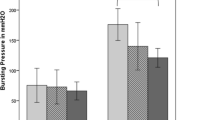Abstract
The purpose of this experimental study was to affirm the protective effect of biodegradable tubes for the intraluminal bypass procedure under the adverse condition of general peritonitis. General peritonitis was induced by means of the cecal ligation and puncture (CLP) model in the rat. The leakage rate in the control group (n=20) without anastomotic protection was 70 percent (14/20). In three therapeutic groups, each consisting of 20 animals, the intestinal anastomoses were protected by an intraluminal bypass tube of different biodegradable biomaterials (collagen-II, BCL-002, and BCL-004). The best results were noted in the collagen-II and BCL-002 groups, where the leakage rates could be reduced to 10 percent. These highly significant results (P=0.0001) prove the feasibility of biodegradable biomaterials for the intraluminal bypass procedure in the rat, even in cases with underlying peritonitis.
Similar content being viewed by others
References
Ger R, Ravo B. Prevention and treatment of intestinal dehiscence by an intraluminal bypass graft. Br J Surg 1984;1:726–9.
Ravo B, Ger R. Intracolonic bypass by an intraluminal tube: an experimental study. Dis Colon Rectum 1984;27:360–5.
Ravo B, Ger R. Temporary colostomy—an outmoded procedure? A report on the intracolonic bypass. Dis Colon Rectum 1984;27:904–7.
Ravo B, Ger R. Management of esophageal dehiscences by an intraluminal bypass tube. Am J Surg 1985;149:733–8.
Winkeltau G, Treutner K-H, Bertram P, Lerch MM, Ger R. The use of biodegradable tubes for intraluminal bypass procedures. Res Surg 1991;3:212–7.
Wichterman KA, Baue AE, Chaudry IH. Sepsis and septic shock—a review of laboratory models and a proposal. J Surg Res 1980;29:189–201.
Fraser I. An historical perspective on mechanical aids in intestinal anastomosis. Surg Gynecol Obstet 1982;155:566–74.
Corman ML, Prager ED, Hardy TG Jr, Bubrick MP, and the Valtrac (BAR) study groups. Comparison of the VALTRAC biofragmentable anastomosis ring with conventional suture and stapled anastomosis in colon surgery: results of a prospective, randomized clinical trial. Dis Colon Rectum 1989;32:183–90.
McCue JL, Phillips RK. Sutureless intestinal anastomoses. Br J Surg 1991;78:1291–6.
Launer DP, Sackier JM. Pouch-anal anastomosis without diverting ileostomy. Dis Colon Rectum 1991;34:993–8.
Author information
Authors and Affiliations
About this article
Cite this article
Winkeltau, G.J., Treutner, KH., Kleimann, E. et al. Protection of intestinal anastomoses by biodegradable intraluminal bypass tubes under the condition of general peritonitis: An experimental study on the CLP model in rats. Dis Colon Rectum 36, 154–160 (1993). https://doi.org/10.1007/BF02051171
Issue Date:
DOI: https://doi.org/10.1007/BF02051171




